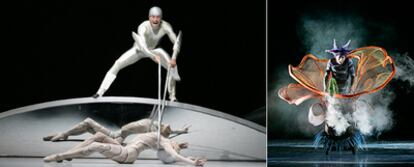The difficulties of dancing to Shakespeare
A show based on the Bard's work comes to Madrid
The lowest and the noblest. All passions, in their vilest and most sublime forms, are represented in the plays of William Shakespeare, and that is the main reason why his work was, is and will continue to be relevant even in the era of cybernetics. Feelings do not have an expiry date - rather, they define us as humans. Mad jealousy is Othello. Existential doubt is Hamlet. Pure evil is Lady Macbeth. Unhealthy greed is Shylock, and Juliet is love.
Although the essence of Shakespeare's plays is theatrical and narrative, the assorted arts have tried to drink from this ingenious source of emotions - in particular, dance.
The great difference between the academic ballet of the 19th century and the neoclassical ballet of the late 20th is that the former's primary interest was technical execution, with the story playing second fiddle to dance; The latter focuses on the story without neglecting the form, but exploring emotions more deeply. And here is where the very classical Shakespeare begins to be part of the history of contemporary dance.
It is not easy to adapt Shakespeare's work. His stories are highly dependent on language, they are complex in terms of narrative, and are filled with subplots and sub-universes. In general, they cannot be transferred with any precision to expressive dance, and that is perhaps why his archetypal characters often appear in the center of the choreographies more as an abstract representation of their own passions than as actual characters in a tale. "Romeo is wildly in love, but you must understand that Juliet is, in and of herself, love itself," the Belgian ballerina Bernice Coppieters remembers being told by Jean-Christophe Maillot, director of Les Ballets de Monte-Carlo, when he was setting up his 1996 version of Romeo and Juliet.
"When you are face to face with these pieces, you realize that they are talking about the same thing: about the difficulties of love," says Maillot, whose company will perform a Shakespeare-based show in Madrid in January. "The fact is that there are substantial anecdotal differences that make them different, and that is the greatness of Shakespeare. If you are going to put on a ballet with them, the dances cannot be an exact reflection of the original plays, nor can they be an intellectual reflection on them, because if I wanted to do it that way, then I would be a painter or a theater director. But I am a choreographer, I have a company of 50 dancers and a public with certain expectations. I like the challenge of connecting with the audience and Shakespeare is perfect for that."
Maillot, who has been the Monaco ballet company's artistic director since 1993, also likes to play with the dramatic relationship between music and dance. For Le Songe (or, The Dream), which the Ballets de Monte-Carlo will perform at Teatros del Canal, he resorted to Mendelssohn, the same composer who provided the music for other versions of A Midsummer Night's Dream by the likes of George Balanchine, Frederick Ashton, John Neumeier and more recently Christopher Wheeldon. But Maillot rarely slides into conventionalism with his adaptations, and in his own delirious version of this comedy, Mendelssohn only provides the background to one of the three worlds in which the play takes place: the land of the humans in Athens. He used the music of Bertrand Maillot for the realm of the comedians, and Daniel Teruggi for the nearly erotic passion of Fairyland.
"Sometimes I feel more like a film director than a choreographer," sighs the 51-year-old Maillot. "I love to exploit the dancers' acting side."
Les Ballets de Monte-Carlo. Le Songe. Until January 24 at Teatros del Canal, C/ Cea Bermúdez 1, Madrid. Tel: 91 308 99 99/50.

Tu suscripción se está usando en otro dispositivo
¿Quieres añadir otro usuario a tu suscripción?
Si continúas leyendo en este dispositivo, no se podrá leer en el otro.
FlechaTu suscripción se está usando en otro dispositivo y solo puedes acceder a EL PAÍS desde un dispositivo a la vez.
Si quieres compartir tu cuenta, cambia tu suscripción a la modalidad Premium, así podrás añadir otro usuario. Cada uno accederá con su propia cuenta de email, lo que os permitirá personalizar vuestra experiencia en EL PAÍS.
¿Tienes una suscripción de empresa? Accede aquí para contratar más cuentas.
En el caso de no saber quién está usando tu cuenta, te recomendamos cambiar tu contraseña aquí.
Si decides continuar compartiendo tu cuenta, este mensaje se mostrará en tu dispositivo y en el de la otra persona que está usando tu cuenta de forma indefinida, afectando a tu experiencia de lectura. Puedes consultar aquí los términos y condiciones de la suscripción digital.
Últimas noticias
Maduro pleads not guilty before the federal court in New York: ‘I am still the president of Venezuela’
A new test can detect Alzheimer’s from a finger prick
UN team enters Sudanese city of El Fasher after paramilitary massacre: ‘It’s like a ghost town’
A recipe for resistance: Indigenous peoples politicize their struggles from the kitchen
Most viewed
- Gilles Lipovetsky: ‘If you want to live better and fall in love, take Prozac, don’t look to philosophy’
- Alain Aspect, Nobel laureate in physics: ‘Einstein was so smart that he would have had to recognize quantum entanglement’
- Maduro’s downfall puts China’s relationship with Venezuela to the test
- Why oil has been at the center of Venezuela-US conflicts for decades
- Alvin Hellerstein, a 92-year-old judge appointed by Bill Clinton, to preside over Maduro’s trial in New York








































